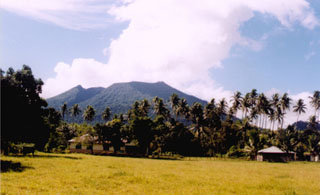Report on Ibu (Indonesia) — 24 April-30 April 2024
Smithsonian Institution / US Geological Survey
Weekly Volcanic Activity Report, 24 April-30 April 2024
Managing Editor: Sally Sennert.
Please cite this report as:
Global Volcanism Program, 2024. Report on Ibu (Indonesia) (Sennert, S, ed.). Weekly Volcanic Activity Report, 24 April-30 April 2024. Smithsonian Institution and US Geological Survey.
Ibu
Indonesia
1.4941°N, 127.6324°E; summit elev. 1357 m
All times are local (unless otherwise noted)
PVMBG reported that Ibu continued to erupt during 24-30 April. Daily white-and-gray ash plumes generally rose as high as 2 km above the summit and drifted in multiple directions. According to a social media post a loud boom followed by a roar accompanied the eruptive event on 26 April. Ash plumes rose as high as 2 km and incandescence emanated in the plume up to 700 m. At 0037 on 28 April a dense gray-to-black plume rose as high as 3.5 km and drifted W. Incandescence emanated from the summit was visible in a webcam image from 29 April. The Alert Level remained at 2 (the second highest level on a four-level scale), with the public advised to stay outside of the 2 km hazard zone and 3.5 km away from the N area of the active crater.
Geological Summary. The truncated summit of Gunung Ibu stratovolcano along the NW coast of Halmahera Island has large nested summit craters. The inner crater, 1 km wide and 400 m deep, has contained several small crater lakes. The 1.2-km-wide outer crater is breached on the N, creating a steep-walled valley. A large cone grew ENE of the summit, and a smaller one to the WSW has fed a lava flow down the W flank. A group of maars is located below the N and W flanks. The first observed and recorded eruption was a small explosion from the summit crater in 1911. Eruptive activity began again in December 1998, producing a lava dome that eventually covered much of the floor of the inner summit crater along with ongoing explosive ash emissions.
Sources: Pusat Vulkanologi dan Mitigasi Bencana Geologi (PVMBG, also known as CVGHM), FPMKI

